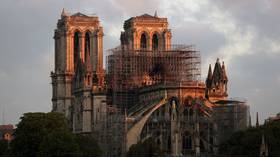New discovery revealed at Notre Dame


The devastating 2019 fire at the Notre-Dame de Paris cathedral has led to a new discovery about the methods used to construct the iconic landmark, after experts leading the cathedral’s restoration efforts investigated previously concealed parts of the building.
The findings were published in the PLOS ONE journal on Wednesday by University Paris 8’s Maxime L'Heritier and his team. They found that Notre-Dame de Paris may be the first known Gothic cathedral to predominantly use iron to bind stones during its construction.
The cathedral was built in the mid-12th century, and was the tallest building ever erected at the time, with vaults peaking at 32 meters (104 feet) in height. Although previous research suggested that this record was achieved by combining a number of architectural innovations, until now, experts still didn’t have a full understanding of the materials used in the construction or how much of a role iron played in the endeavor.
The 2019 fire, however, has allowed archeologists to access previously unseen parts of Notre-Dame. L’Heritier and his team were able to obtain samples of material from 12 iron staples used to bind stones together in different parts of the building, including the tribunes, nave aisles and upper walls.
The researchers used a number of analysis methods, including radiocarbon dating as well as microscopic, chemical and metallurgical analysis. The team found that iron staples were used in the earliest phases of construction in the 1160s, making it the first such building to use iron staples throughout its entire structure.
The analysis has led not only to a better understanding of how the Parisian master masons constructed the cathedral, but has also shed details on the iron supply of the building yard and the iron circulation, trade and forging in 12th- and 13th-century Paris.
The reconstruction of the Notre Dame de Paris cathedral after the April 15, 2019 fire is still ongoing and is expected to take some twenty years to complete. However, the restoration efforts have led to some important discoveries. Previously, archeologists had found several tombs and a 14th-century sarcophagus – both “of remarkable scientific quality,” as well as pieces of painted sculptures that are thought to be part of the original decorations.